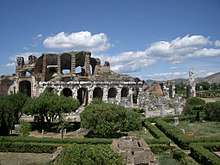Lucrinus Lacus
Lucrinus Lacus, or Lucrine Lake (Italian: Lago di Lucrino; Neapolitan: Laco 'e Lucrine) is a lake of Campania, southern Italy, less than one kilometre to the south of Lake Avernus. Present-day lake looking southwest from Monte Nuovo; breakers on the Gulf of Pozzuoli are glimpsed at left, Lago d'Averno at upper right. The lake is separated from the sea (the Gulf of Pozzuoli) by a narrow strip of land that is traversed by the coast road, the Via Herculanea, and by a modern railway. The road runs on an embankment, the construction of which was traditionally attributed to Heracles in Strabo's time. This strip was reinforced with a sea wall, "where the sea angrily dashes, but is thrust back with echoing roar" and severed by Marcus Vipsanius Agrippa, in order to make a harbour of Lake Lucrinus, which he joined to Avernus by a canal, as mentioned in Virgil's Georgics.[1]
| Lucrinus Lacus | |
|---|---|
| Lucrine Lake | |
Present-day lake looking southwest from Monte Nuovo; breakers on the Gulf of Pozzuoli are glimpsed at left, Lago d'Averno at upper right. | |
 Lucrinus Lacus | |
| Location | Campania, Italy |
| Coordinates | 40°49′46″N 14°4′49″E |
| Type | Lake |
| Native name | Lago di Lucrino, Laco 'e Lucrine |
The size of present-day Lago Lucrino, also known as the maricello ("little sea"), was much reduced by the rise of the cratered volcanic cone of the Monte Nuovo in 1538.[2] The length of the former dyke that separated it from the sea, a length of about 1.5 kilometres (0.93 mi), can be traced by skin divers. Its greatest depth is about 5 metres (16 ft).[3]
In Roman days its fisheries were important and its oyster-beds, whose foundation is attributed to one Sergius Orata in about 100 BC, were renowned - as they are today.
It was also in favour as a resort for pleasure excursions from Baiae (cf. Martial i. 62) and its banks were covered with villas, of which the best known was Cicero's villa Cumanum, the seat of his Academia, on the east bank. The remnants of this villa, with the village of Tripergola, disappeared beneath the sea in 1538. In 59, according to Tacitus, Agrippina the Younger proceeded to her villa on this lake's shore after the shipwreck arranged by Nero was bungled and she had managed to swim to some boats and thence arrive ashore.
Notes
- Virgil, Georgics ii.161-64.
- Antonio Parascandola. "Il Monte Nuovo ed il Lago Lucrino", in: Bollettino della Società dei Naturalisti in Napoli, vol. LV, 1944-1946.
- Mario Sirpettino "At the bottom of the sea: the remains of Portus Julius"
References

- Karl Julius Beloch, Campanien, ed. 2 (Breslau, 1890), 172.


